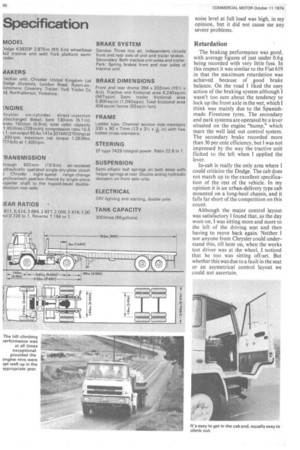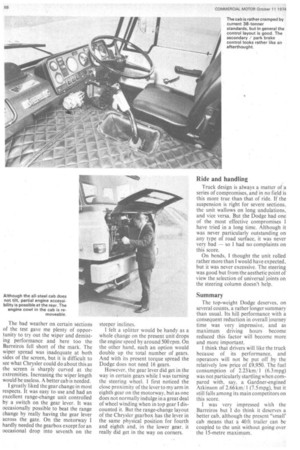Dodge K3820WYork 32-ton-gcw artic
Page 67

Page 68

Page 70

If you've noticed an error in this article please click here to report it so we can fix it.
\ROAD TEST AND \OPERATIONAL JRIAL 17174 THE DODGE K3820P built at the Barreiros plant of Chrysler Espana and introduced to the UK market last year at a designed gcw of 38 tonnes (37.4 tons). has 270 bhp on tap — an excellent onpaper specification; and now the C
, Scottish road test results have confirmed this. Its performance up the hills was second lo none on this route. ,
On the motorway sections, the Barrel ros (Chrysler does not like this name beinguid bui it sounds better than K 3;420Pi cruised comfortably at the 60 mpn limit and held its speed up
the inclines, such as Keele, extremely well.
Its fuel consumption on the motorway was average for this weight but not exceptional. On the run down to London on the second day from .Leicester to Hemel Hempstead the Dodge averaged nearly 2.5 km/ 1 (7mpg), while on the twisty section around West Woodburn, this dropped to 2.2 km 1 (6mpg). But so far as was concerned this only averagely good fuel consumption was more than compensated by the total iourney time.
Many operators are wary of high-performance trucks. thinking that their performance is paid for by high fuel consumption. Usually, the opposite is the case, but When in 1976 the driving-hours limits arc reduced then shorter journey
times will become more important.
The Dodge completed the wh( route in 16 hours 46 minutes, which around two hours less than average.
Being turbocharged, the Spani, built engine prefers to work in t upper-speed range in order to keep t turbine speed up. Although it could r be described as an inflexible unit, it v. not at its best below around 1,500 rp but the power really came in above t figure.
This turbine characteristic could hzalso accounted for the in-cab noise le almost non-existent at part and tn ing-throttle, but coming in with a roar soon as my foot went down. With rn. trucks the noise level comes in gradua as a function of engine speed, but w the Dodge it was all or nothing. 1 noise level at full load was high, in my opinion, but it did not cause me any severe problems.
Retardation
The braking performance was good, with average figures of just under 0.6 g being recorded with very little fuss. In this respect it was similar to the Fiat 619 in that the maximum retardation was achieved because of good brake balance. On the road I liked the easy action of the braking system although I wasn't too sure about the tendency to lock up the front axle in the wet, which I think was mainly due to the Spanishmade Firestone tyres. The secondary and park systems are operated by a lever situated on the engine "hump," which mars the well laid out control system. The secondary brake recorded more than 30 per cent efficiency, but I was not impressed by the way the tractive unit flicked to the left when I applied the lever.
In-cab is really the only area where I could criticize the Dodge. The cab does not match up to the excellent specification of the rest of the vehicle. In my opinion it is an urban-delivery type cab mounted on a long-haul chassis, and it falls far short of the competition on this count.
Although the major control layout was satisfactory I found that, as the day wore on, I was sitting more and more to the left of the driving seat and then having to move back again. Neither I nor anyone from Chrysler could understand this, till later on, when the works test driver was at the wheel, I noticed that he too was sitting off-set. But whether this was due to a fault in the seat or an asymetrical control layout we could not ascertain.
The bad weather on certain sections of the test gave me plenty of opportunity to try out the wiper and demisting performance and here too the Barreiro's fell short of the mark. The wiper spread was inadequate at both sides of the screen, but it is difficult to see what Chrysler could do about this as the screen is sharply curved at the extremities. Increasing the wiper length would be useless. A better cab is needed.
I greatly liked the gear change in most respects. It was easy to use and had an excellent range-change unit controlled by a switch on the gear lever. It was occasionally possible to beat the range change by really having the gear lever across the gate. On the motorway I hardly needed the gearbox except for an occasional drop into seventh on the steeper inclines.
I felt a splitter would be handy as a whole change on the present unit drops the engine speed by around 500 rpm. On the other hand, such an option would double up the total number of gears. And with its present torque spread the Dodge does not need 16 gears.
However, the gear lever did get in the way in certain gears while I was turning the steering wheel. I first noticed the close proximity of the lever to my arm in eighth gear on the motorway, but as one does not normally indulge in a great deal of wheel winding when in top gear I discounted it. But the range-change layout of the Chrysler gearbox has the lever in the same physical position for fourth and eighth and, in the lower gear, it really did get in the way on corners.
Ride and handling
Truck design is always a matter of a series of compromises, and in no field is this more true than that of ride. If the suspension is right for severe sections, the unit wallows on long undulations, and vice versa. But the Dodge had one of the most effective compromises I have tried in a long time. Although it was never particularly outstanding on any type of road surface, it was never very bad — so I had no complaints on this score.
On bends, I thought the unit rolled rather more than I would have expected, but it was never excessive. The steering was good but from the aesthetic point of view the selection of universal joints on the steering column doesn't help.
Summary The top-weight Dodge deserves, on several counts, a rather longer summary than usual. Its hill performance with a consequent reduction in overall journey time was very impressive, and as maximum driving hours become reduced this factor will become more and more important.
I think that drivers will like the truck because of its performance, and operators will not be put off by the relatively low price of £9,950. The fuel consumption of 2.23 km/ 1 (6.3 mpg) was not particularly startling when compared with, say, a Gardner-engined Atkinson of 2.66 km/ 1 (7.5 mpg), but it still falls among its main competitors on this score.
I was very impressed with the Barreiros but I do think it deserves a better cab, although the present "small' cab means that a 40 ft trailer can be coupled to the unit without going over the 15-metre maximum.




























































































































































